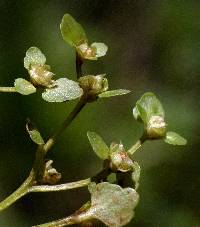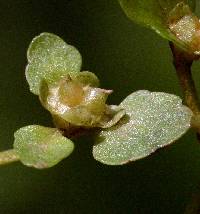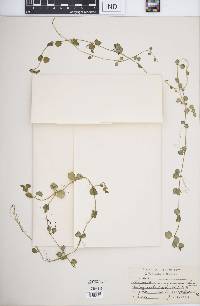|
|
|
|
Family: Saxifragaceae
American golden saxifrage
|
Stolons white or tan, 0.3-1 mm diam., glabrous. Flowering stems repent, decumbent, or ascending, branching in distal 1/4-1/2, 4-30 cm, glabrous. Leaves opposite, sometimes alternate distally, membranous. Stolon leaves: petiole 1-4 mm, glabrous; blade ovate to depressed-ovate, round, or flabellate, 2.5-15 × 2-10(-20) mm, base attenuate to cordate, margins subentire or 5-7(-9)-crenate or -crenulate, not purple-spotted, glabrous, surfaces glabrous abaxially and adaxially. Cauline leaves 4-9; petiole absent or 0.1-4 mm, glabrous; blade ovate to depressed-ovate, round, or flabellate, 2.5-15 × 2-10(-20) mm, base attenuate to cordate, margins 5-7(-9)-crenate or -crenulate, glabrous, surfaces glabrous abaxially and adaxially. Inflorescences terminal or axillary solitary flowers or 2-10-flowered, open cymes; bracts green, not purple-spotted, foliaceous, ovate to flabellate, 2-7 × 2-7 mm, margins subentire or 5-7-crenate or -crenulate. Pedicels absent or 0.1-0.8 mm. Flowers: hypanthium green, not purple-spotted, turbinate, 0.9-1.8 × 1.4-2.6 mm, glabrous; sepals spreading to erect, green, greenish yellow, or greenish red, not purple-spotted or purplish brown-spotted distally, broadly triangular or broadly ovate to nearly round, 1.3-1.8 × 0.9-1.6 mm, apex obtuse to rounded; nectary disc conspicuous, green or purple, 8-lobed; stamens 4-8, 0.5-0.9 mm; anthers purple, red, or orange, 0.2-0.3 × 0.4-0.5 mm; styles 0.2-0.6 mm. Seeds 6-16, dark brown, spheroid to ovoid, (0.5-)0.6-0.8 mm, puberulent. 2n = 18, 24. Flowering Mar-Jul. Marshy ground, streamsides, seeps, springs, swampy woods; 0-1500 m; N.B., N.S., Ont., P.E.I., Que.; Conn., Del., Ga., Ind., Maine, Md., Mass., Mich., Minn., N.H., N.J., N.Y., N.C., Ohio, R.I., S.C., Tenn., Vt., Va., W.Va., Wis. Perennial herb 5 - 20 cm tall Stem: slender, branching, trailing along the ground but with ascending branch tips (decumbent). Leaves: opposite (lower leaves) and alternate (upper leaves), short-stalked, 5 - 15 mm long, egg-shaped to nearly round, non-toothed or irregularly toothed. Flowers: borne solitary at branch tips, 4 - 5 mm wide, lacking petals but having egg-shaped sepals that are greenish yellow to greenish red or green with brownish purple. The flower center has an eight-lobed disk that is red to brownish purple or green with eight short stamens attached between the lobes. Fruit: a many-seeded, two-lobed capsule splitting open across the top. Similar species: Chrysosplenium americanum is unique to the Saxifragaceae species in the Chicago Region because its leaves and flowers are borne on the same stem and the flowers have eight stamens but lack petals. Flowering: early April to early May Habitat and ecology: This species prefers cool, shaded, springy or muddy soil, and is most commonly found in Barrien County along the Paw Paw River and occasionally found in the dune region. Occurence in the Chicago region: native Etymology: Chrysosplenium comes from the Greek words chrysos, meaning gold, and splen, meaning spleen, likely referring to supposed medicinal properties. Americanum means "from America." Author: The Morton Arboretum Stems decumbent, branched, 5-20 cm; lvs all short- petioled, the lower opposite, the upper alternate, ovate to rotund, 5-15 mm, entire or obscurely and irregularly toothed; fls solitary at the end of the branches, 4-5 mm wide, the ovate sep greenish-yellow or greenish-red or green marked with brown-purple, the disk red or brown-purple or green; stamens mostly 8; 2n=24. Springy or muddy soil, usually in shade; Que. and Ont. to Sask., s. to Va., Ky., and Ind. Apr.-June. Gleason, Henry A. & Cronquist, Arthur J. 1991. Manual of vascular plants of northeastern United States and adjacent Canada. lxxv + 910 pp. ©The New York Botanical Garden. All rights reserved. Used by permission. |





